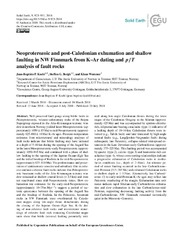Neoproterozoic and post-Caledonian exhumation and shallow faulting in NW Finnmark from K–Ar dating and p/T analysis of fault rocks
Permanent link
https://hdl.handle.net/10037/13995Date
2018-07-20Type
Journal articleTidsskriftartikkel
Peer reviewed
Abstract
Well-preserved fault gouge along brittle faults in
Paleoproterozoic, volcano-sedimentary rocks of the Raipas
Supergroup exposed in the Alta–Kvænangen tectonic window
in northern Norway yielded latest Mesoproterozoic (approximately
1050 15 Ma) to mid-Neoproterozoic (approximately
825–810 18 Ma) K–Ar ages. Pressure–temperature
estimates from microtextural and mineralogy analyses of
fault rocks indicate that brittle faulting may have initiated
at a depth of 5–10 km during the opening of the Asgard Sea
in the latest Mesoproterozoic–early Neoproterozoic (approximately
1050–945 Ma) and continued with a phase of shallow
faulting to the opening of the Iapetus Ocean–Ægir Sea
and the initial breakup of Rodinia in the mid-Neoproterozoic
(approximately 825–810 Ma). The predominance and preservation
of synkinematic smectite and subsidiary illite in cohesive
and non-cohesive fault rocks indicate that Paleoproterozoic
basement rocks of the Alta–Kvænangen tectonic window
remained at shallow crustal levels (< 3.5 km) and were
not reactivated since mid-Neoproterozoic times. Slow exhumation
rate estimates for the early–mid-Neoproterozoic
(approximately 10–75mMyr-1) suggest a period of tectonic
quiescence between the opening of the Asgard Sea
and the breakup of Rodinia. In the Paleozoic, basement
rocks in NW Finnmark were overthrusted by Caledonian
nappes along low-angle thrust detachments during
the closing of the Iapetus Ocean–Ægir Sea. K–Ar dating
of non-cohesive fault rocks and microtexture mineralogy
of cohesive fault rock truncating Caledonian nappe
units show that brittle (reverse) faulting potentially initiated
along low-angle Caledonian thrusts during the latest
stages of the Caledonian Orogeny in the Silurian (approximately
425 Ma) and was accompanied by epidote–chloriterich,
stilpnomelane-bearing cataclasite (type 1) indicative of
a faulting depth of 10–16 km. Caledonian thrusts were inverted
(e.g., Talvik fault) and later truncated by high-angle
normal faults (e.g., Langfjorden–Vargsundet fault) during
subsequent, late Paleozoic, collapse-related widespread extension
in the Late Devonian–early Carboniferous (approximately
375–325 Ma). This faulting period was accompanied
by quartz- (type 2), calcite- (type 3) and laumontite-rich cataclasites
(type 4), whose cross-cutting relationships indicate
a progressive exhumation of Caledonian rocks to zeolitefacies
conditions (i.e., depth of 2–8 km). An ultimate period
of minor faulting occurred in the late Carboniferous–
mid-Permian (315–265 Ma) and exhumed Caledonian rocks
to shallow depth at 1–3.5 km. Alternatively, late Carboniferous
(?) to early–mid-Permian K–Ar ages may reflect late
Paleozoic weathering of the margin. Exhumation rates estimates
indicate rapid Silurian–early Carboniferous exhumation
and slow exhumation in the late Carboniferous–mid-
Permian, supporting decreasing faulting activity from the
mid-Carboniferous. NW Finnmark remained tectonically
quiet in the Mesozoic–Cenozoic.
Description
Source at: https://doi.org/10.5194/se-9-923-2018


 English
English norsk
norsk